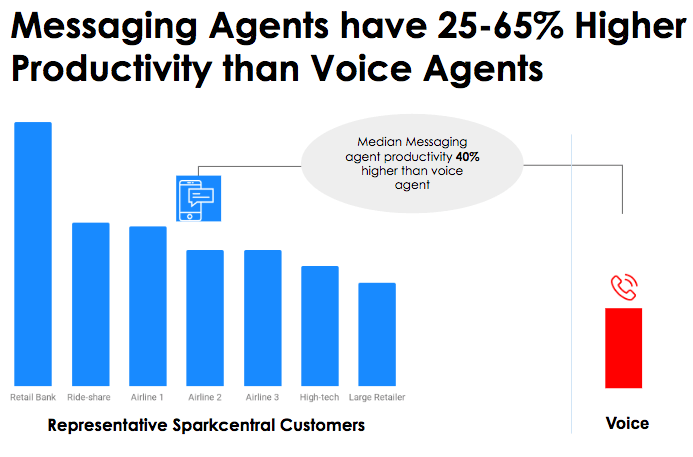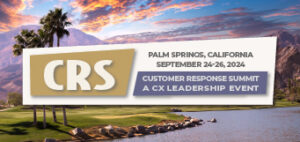The following is a guest post by Abhay Prasad, Vice President, Product Management for Sparkcentral. To learn more about Sparkcentral visit their website.
Messaging Customer Care: Real-World Deployments, Real Results
The goal of this blog post is to clearly identify the business value of implementing messaging customer care alongside traditional care channels such as phone, email, and live-chat. In my role as Head of Product, I have the privilege of meeting customer service and customer experience leaders on a weekly basis. Over the last several years of my career, I have racked up several hundred such conversations.
These conversations are a part of my role that I love and value immensely because they help me understand our customers’ priorities. While every organization has its own way of articulating their customer service priorities, they generally fall into three main buckets: improving customer experience, controlling customer service costs, and improving agent satisfaction. Agent productivity impacts all three of these commonly held priorities.
Improving agent productivity means conversations are being resolved faster which is a key component of customer satisfaction. It also impacts agent satisfaction because higher productivity is achieved by eliminating repetitive, mundane or wasteful actions that agents are required to do for issue resolution. Finally, and most significantly, agent productivity is directly tied to cost control since its presence enables organizations to handle higher volumes of customer service requests.
In previous posts, we’ve talked about how messaging customer care provides superior CX for consumers. What’s often overlooked is that customer care over messaging channels is also significantly cheaper compared to other, more traditional channels including voice and textual channels such as email and live chat. This is largely because messaging enables agents to dramatically increase productivity.
Voice vs. Messaging
To understand how much more productive, we analyzed a representative sample of our customer base. We found that agents on our platform are able to resolve between 5.7 to 14.5 conversations per hour. This resolution rate is about 25-65% higher than that of voice teams. The median messaging customer care team resolves 7.2 conversations per hour. This is about 42% higher than the benchmark of 4.2-5.2 resolutions per hour for a voice agent. This does not include conversations that did not require a response (e.g., conversations resolved by bots and automation, or a “Thank you” from a customer after a conversation was already marked resolved by an agent). Also excluded are additional conversations conducted by agents that were never resolved.
This disparity in productivity is driven by a messaging agent’s ability to handle many more simultaneous conversations than a voice agent is able to. Agents on our platform often have more than 10 conversations being actively handled at once without jeopardizing the quality of service.

Email vs. Messaging
Messaging provides an even higher productivity gain over email. Email, like messaging, is an asynchronous channel. This means that conversations don’t have to happen in real time and can span minutes, hours, or even days. However, from a consumer’s point of view, email is a highly dissatisfying channel, associated with high response times (often a day, sometimes several days) and high friction.
Emails tend to need more words compared to messaging which wastes agents’ time without adding much value to the actual problem resolution for the consumer. This communication style often requires a lot of back and forth, which feels natural in a messaging-style conversation, but can get frustrating in a more “offline” format. Email issue resolution costs for enterprises that we’ve talked to tend to be in the range of $6-7 per resolution. Compare this to the $2-2.5 cost per resolution for an average messaging team on our platform and it translates into a 60-65% productivity gain over email agent teams.
Chat vs. Messaging
Live chat has been around for a long time and is a well-established service channel in many organizations. On the surface messaging and chat look similar enough that enterprises tend to assume that they also have similar costs. However, this is not the case due to a key difference between messaging and chat: asynchronous versus synchronous interactions. Chats often suffer from a high abandonment rate whereas a messaging conversation can never be abandoned. This is the source of messaging’s productivity advantage over chat. Messaging conversations never get abandoned as there are no session timeouts.
Timed out chats often lead to either channel hopping or new chat sessions (e.g., if a user gets timed out because they were browsing a different webpage and didn’t see an agent’s reply). For each abandoned chat that drives a new session or a phone call, the time spent by the first chat agent is wasted productivity.
Messaging also allows more simultaneous conversations than live chat’s typical 3-5 range. We estimate that eliminating involuntary abandons and enabling higher simultaneous conversations can add up to 15-30% higher productivity over live chat. Abandonment rate being the key variable for the extent of these savings.
Whether comparing messaging customer care to voice, email or live-chat, it is safe to say the messaging provides a superior customer experience. Perhaps most importantly, it drives 20-60% agent productivity compared to traditional channels, creating a win-win situation for the consumer and the enterprise.
Messaging provides a superior customer experience and drives 20-60% agent productivity compared to traditional channels, creating a win-win situation for the consumer and the enterprise.
What is your experience? Have you looked at what a messaging operation could save your organization?
Interested in finding out more about this topic or Sparkcentral? Sparkcentral is one of the subject matter experts that will be sharing their insights and expertise at Customer Response Summit Marina del Rey, September 10-12, 2018. CR Summit Marina del Rey will feature keynotes from Chick-fil-A, Microsoft, LinkedIn, and Upwork. Sparkcentral will be delivering a Customer Shop Talk session titled “Digital Messaging Customer Care at Scale”.
For more information about our leading event for CX professionals, visit our event website.

